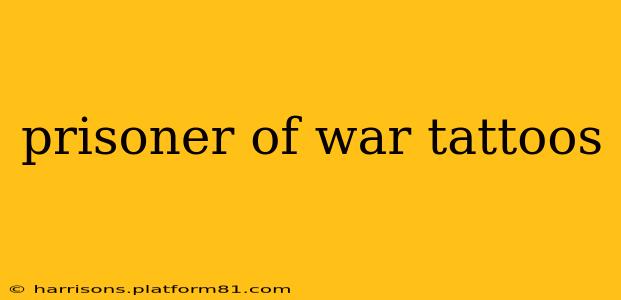Prisoner of War (POW) tattoos hold a powerful and poignant significance, serving as enduring symbols of resilience, survival, and the shared experience of captivity. These tattoos, often discreet yet deeply meaningful, tell stories of hardship, camaraderie, and the unwavering spirit of those who endured unimaginable circumstances. This article delves into the history, symbolism, and cultural impact of POW tattoos, exploring the diverse ways they manifest and the profound emotions they evoke.
What do POW tattoos symbolize?
POW tattoos often symbolize a prisoner's resilience, their time in captivity, and their eventual return home. They can be a testament to survival against overwhelming odds, a tribute to fallen comrades, or a silent declaration of defiance against their captors. Common symbols include dates of capture and release, military unit insignia, and representations of freedom or hope, like birds in flight or a compass. The design choices often reflect the individual's personal experiences and beliefs.
What are some common POW tattoo designs?
While the imagery varies greatly, several common themes and symbols emerge in POW tattoos:
-
Dates: The dates of capture and release are frequently inked, serving as a tangible reminder of the duration of captivity. These dates often hold profound personal meaning and represent a significant chapter in the individual's life.
-
Military Unit Insignia: Insignia representing the soldier's unit offers a sense of belonging and shared experience. It can also serve as a symbol of pride in their military service, even amidst the trauma of captivity.
-
National Flags or Emblems: National symbols represent unwavering loyalty and patriotism, particularly significant for individuals enduring the psychological pressures of captivity.
-
Abstract Designs: Sometimes, less literal symbols are used, representing themes such as hope, freedom, or perseverance. These designs can be intensely personal and symbolic, carrying a deeper, unspoken message.
-
Names or Portraits: The names or portraits of fellow soldiers who died in captivity or during the war are powerful reminders of shared sacrifice and unwavering bonds of brotherhood.
Are POW tattoos always visible?
No, POW tattoos are not always visible. Many veterans choose discreet placement, opting for small, hidden tattoos that serve as personal reminders rather than public declarations. The decision about placement and visibility is deeply personal and reflects the individual's comfort level and desire to share their experience.
What is the history of POW tattoos?
The tradition of POW tattoos likely started during World War II and the Korean War, as soldiers turned to this form of self-expression to mark their experiences and cope with the trauma of captivity. The practice has continued, evolving in style and symbolism, reflecting changes in warfare and social attitudes.
How do POW tattoos differ from other military tattoos?
While all military tattoos can hold significant meaning, POW tattoos carry a unique weight. They specifically commemorate the experiences of captivity, reflecting the enduring psychological and physical challenges faced by prisoners of war. They are a visual testament to an ordeal that profoundly shapes the individual's identity and perspective.
Why are POW tattoos important?
POW tattoos serve as potent reminders of the sacrifices made by those who served their country and endured the harrowing experience of captivity. These enduring emblems offer a glimpse into the resilience of the human spirit and act as a poignant tribute to the often unseen battles fought in the shadows of war. They are testaments to individual stories of survival and a profound symbol of the shared experience of those who endured imprisonment. The importance of these tattoos lies in their profound personal meaning and the enduring legacy they represent for generations to come.
How are POW tattoos viewed today?
Today, POW tattoos are viewed with respect and understanding. They are recognized as powerful symbols of resilience and remembrance, serving as a vital part of the veteran’s narrative and a shared history within military communities. The tattoos are a testament to the enduring human spirit and the profound impact of war and captivity. The significance of these tattoos lies not only in the artistry but also in the untold stories they silently carry, fostering a deeper connection to the experiences and sacrifices of those who endured imprisonment.
